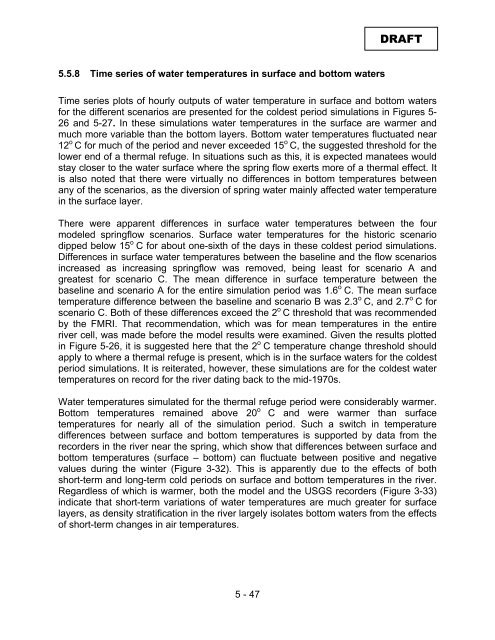The Determination of Minimum Flows for Sulphur Springs, Tampa
The Determination of Minimum Flows for Sulphur Springs, Tampa
The Determination of Minimum Flows for Sulphur Springs, Tampa
You also want an ePaper? Increase the reach of your titles
YUMPU automatically turns print PDFs into web optimized ePapers that Google loves.
DRAFT<br />
5.5.8 Time series <strong>of</strong> water temperatures in surface and bottom waters<br />
Time series plots <strong>of</strong> hourly outputs <strong>of</strong> water temperature in surface and bottom waters<br />
<strong>for</strong> the different scenarios are presented <strong>for</strong> the coldest period simulations in Figures 5-<br />
26 and 5-27. In these simulations water temperatures in the surface are warmer and<br />
much more variable than the bottom layers. Bottom water temperatures fluctuated near<br />
12 o C <strong>for</strong> much <strong>of</strong> the period and never exceeded 15 o C, the suggested threshold <strong>for</strong> the<br />
lower end <strong>of</strong> a thermal refuge. In situations such as this, it is expected manatees would<br />
stay closer to the water surface where the spring flow exerts more <strong>of</strong> a thermal effect. It<br />
is also noted that there were virtually no differences in bottom temperatures between<br />
any <strong>of</strong> the scenarios, as the diversion <strong>of</strong> spring water mainly affected water temperature<br />
in the surface layer.<br />
<strong>The</strong>re were apparent differences in surface water temperatures between the four<br />
modeled springflow scenarios. Surface water temperatures <strong>for</strong> the historic scenario<br />
dipped below 15 o C <strong>for</strong> about one-sixth <strong>of</strong> the days in these coldest period simulations.<br />
Differences in surface water temperatures between the baseline and the flow scenarios<br />
increased as increasing springflow was removed, being least <strong>for</strong> scenario A and<br />
greatest <strong>for</strong> scenario C. <strong>The</strong> mean difference in surface temperature between the<br />
baseline and scenario A <strong>for</strong> the entire simulation period was 1.6 o C. <strong>The</strong> mean surface<br />
temperature difference between the baseline and scenario B was 2.3 o C, and 2.7 o C <strong>for</strong><br />
scenario C. Both <strong>of</strong> these differences exceed the 2 o C threshold that was recommended<br />
by the FMRI. That recommendation, which was <strong>for</strong> mean temperatures in the entire<br />
river cell, was made be<strong>for</strong>e the model results were examined. Given the results plotted<br />
in Figure 5-26, it is suggested here that the 2 o C temperature change threshold should<br />
apply to where a thermal refuge is present, which is in the surface waters <strong>for</strong> the coldest<br />
period simulations. It is reiterated, however, these simulations are <strong>for</strong> the coldest water<br />
temperatures on record <strong>for</strong> the river dating back to the mid-1970s.<br />
Water temperatures simulated <strong>for</strong> the thermal refuge period were considerably warmer.<br />
Bottom temperatures remained above 20 o C and were warmer than surface<br />
temperatures <strong>for</strong> nearly all <strong>of</strong> the simulation period. Such a switch in temperature<br />
differences between surface and bottom temperatures is supported by data from the<br />
recorders in the river near the spring, which show that differences between surface and<br />
bottom temperatures (surface – bottom) can fluctuate between positive and negative<br />
values during the winter (Figure 3-32). This is apparently due to the effects <strong>of</strong> both<br />
short-term and long-term cold periods on surface and bottom temperatures in the river.<br />
Regardless <strong>of</strong> which is warmer, both the model and the USGS recorders (Figure 3-33)<br />
indicate that short-term variations <strong>of</strong> water temperatures are much greater <strong>for</strong> surface<br />
layers, as density stratification in the river largely isolates bottom waters from the effects<br />
<strong>of</strong> short-term changes in air temperatures.<br />
5 - 47

















